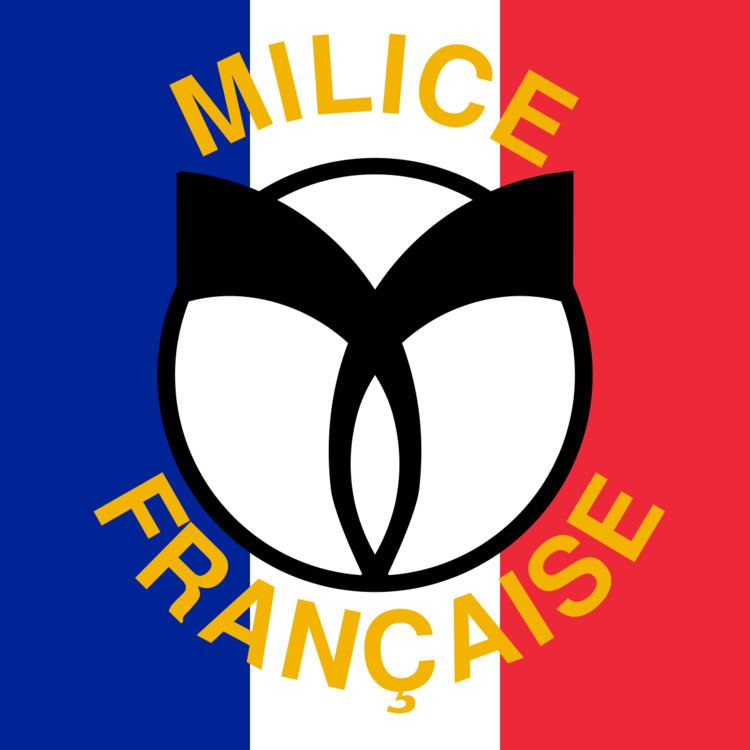Active 1943-44 Size 4000 | Country France Type Armed militia | |
 | ||
Role To support the national revolution | ||
The Franc-Garde (English: Free Guard) was the armed wing of the French Milice (Militia) and was taken alone or alongside German forces in major battles against the Maquis from late 1943 to August 1944.
Contents
History
The Franc-Garde, soon announced the creation of the French Militia on 30 January 1943, was actually implemented June 2 the same year in Calabria camp near Vichy. Its field of action, initially confined to the former free zone, was formally extended to the former occupied zone as of January 27, 1944. His role was to support the national revolution undertaken by the Vichy government in predominantly involved in policing, but also assisting, inter alia, the clearing of bombed cities. In the words of Secretary General of the French Militia, Joseph Darnand, in his keynote address January 30, 1943, the Franc-Garde should be "educated and technically prepared to fight to be always ready to maintain the order ". It was his review: The Assault.
The Franc-Garde consisted of two parts:
- Free-Standing Garde, cantoned and unpaid, and
- the franc-Garde volunteer, whose members, militiamen ordinary screened, could be mobilized through precise and timely action when summoned.
The first two were trained thirty piloted in cities where dissent was the most active: Lyon and Annecy. The names of thirty hundred and should not be misled on the real effective. For example, the trentaine d'Annecy, became hundred, had only 72 men in May 1944. According to the Information Service of the French Committee of National Liberation in February 1944, the Franc-Garde men gathered in 1687, a cohort in Vichy, a hundred in Lyon, Marseille and Toulouse, and thirty in each of forty-five departments of the south. In any case, even with the mobilization of volunteers in the spring and summer 1944, the size of the Franc-Garde never exceeded 4,000 men.
In principle, any intervention by the Free Guard should be preceded by a verbal or written requisition sent by the prefect to the officer commanding the unit required, which was not always the case in practice.
In October - November 1944, facing the advance of allied troops, thousands of militiamen (10 to 15 000 active militants) left the national territory. Among them, about 2,500 franc-gardes were declared fit to fight:
Organization and equipment
The Franc-Garde consisted of volunteers (typically, after a year's membership in the Militia), aged 18 to 45 years old, who lived in barracks and were paid based on the official salary of a sergeant of the Police National.
The francs-gardes, the only militia in uniform, adopted the dark blue dress Alpine model 1941 ("ski" trousers worn with gaiters and boots, jacket and belt, khaki shirt, black tie, beret tilted to the left).
The symbol of a white Greek letter gamma, on black, was used in a metal badge worn in the right buttonhole and in an embroidered badge on the beret. In combat situations, usually in the fight against the guerrillas, the Franc-garde could wear an Adrian helmet.
Because of the reluctance of the German Army, the Franc-Garde was only slowly and gradually armed. Its officers had pistols from the outset, but it was not until autumn 1943, following the upsurge in attacks against its members, that the Franc-Garde received some pistols recovered from British drops to the Resistance. In January 1944 the Franc-Garde was authorized to draw on stockpiles of arms built up after the military armistice, and in March 1944 it was authorized to form a section of machine guns and mortars to participate in the attack on the wooded country of Glières. Finally, each Ten was equipped with two Sten submachine guns, the French MAC 24/29 machine gun and MAS 36 rifles. Following a German refusal, the Franc-Garde could never get heavy weapons, artillery or armored vehicles.
In 1944, a Franc-Garde school was set up in Poitiers.
